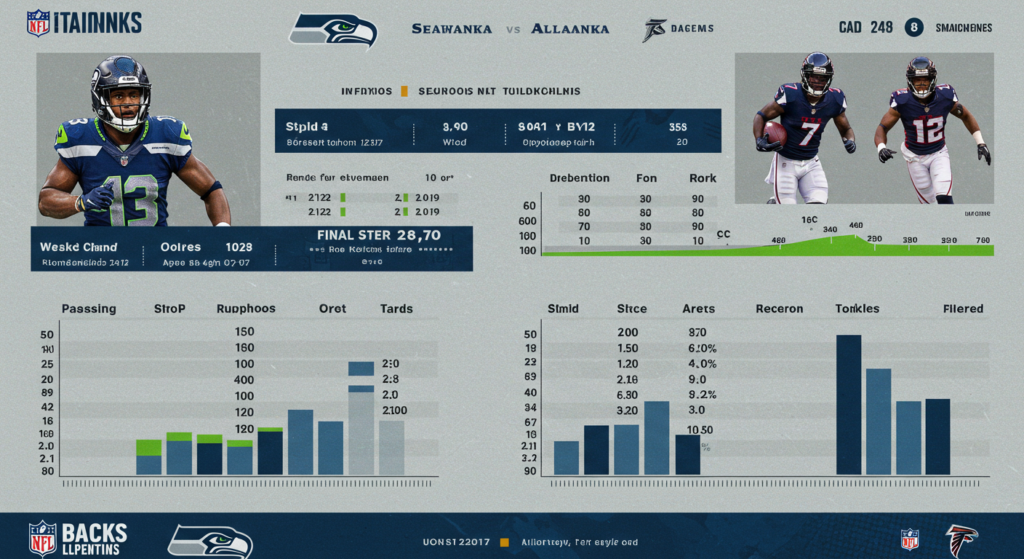Introduction
The clash between the Seattle Seahawks and the Atlanta Falcons always draws attention, and the latest meeting did not disappoint. Fans on both sides came away buzzing about standout moments, big plays, and the individual performances that defined the game. To fully appreciate how this matchup unfolded, it’s essential to dig into the Seahawks vs Atlanta Falcons match player stats. Numbers don’t just tell the story—they reveal who stepped up under pressure, who struggled, and how small details swung the momentum.
This particular matchup offered a fascinating contrast in playing styles. The Seahawks leaned heavily on their balanced offense, mixing aerial attacks with steady ground gains, while the Falcons relied on quick strikes and explosive bursts to stay in the contest. From quarterback battles to defensive resilience, the player stats from this game give us a clear window into how each team executed its strategy.
By reviewing the Seahawks vs Atlanta Falcons match player stats, we can highlight the quarterbacks’ efficiency, the receivers who made the difference, and the defenders who either held the line or gave up big yardage. Numbers like passing yards, completion percentages, tackles, and turnovers reveal far more than what the scoreboard shows. They demonstrate the hidden storylines that shaped the outcome and provide insight into what each team can build on moving forward.
For fans, analysts, and even casual observers, these stats help paint a complete picture of the Seahawks and Falcons’ recent showdown. Whether you’re comparing quarterback duels, studying defensive efficiency, or analyzing special teams, there’s a lot to unpack. Let’s break down the numbers and see how the game was truly won and lost.
Quarterback Performances Define the Match
The quarterback duel was one of the most exciting aspects of the Seahawks vs Atlanta Falcons match player stats. On Seattle’s side, the starting quarterback displayed poise under pressure, consistently hitting mid-range throws and managing the clock effectively. Completion percentage was key, and the Seahawks’ signal-caller delivered with accuracy that kept drives alive. Even when pressured by the Falcons’ pass rush, he showed mobility and quick decision-making, limiting costly mistakes. His ability to connect on third downs shifted momentum in Seattle’s favor multiple times throughout the game.
On the other hand, the Falcons’ quarterback took a more aggressive approach. Pushing the ball downfield, he tested Seattle’s secondary with deep passes and sideline throws. While this strategy generated explosive plays, it also came with risks—turnovers became a factor, as forced throws into tight coverage occasionally backfired. Still, his resilience stood out. Even after an interception, he bounced back with confidence, leading touchdown drives that kept the Falcons competitive. The quarterback stats reflected both the high-risk, high-reward nature of his play and the heart he showed under pressure.
Running Game Impact
The Seahawks’ rushing attack played a critical role in controlling the tempo. Their lead running back put up impressive yardage, using vision and patience to exploit gaps in the Falcons’ defensive line. Consistently gaining solid yardage on first downs helped set up manageable second and third downs, opening up the play-action passing game. The running game stats showed not just raw yardage, but also efficiency—yards after contact and broken tackles highlighted the physical edge Seattle brought.
Meanwhile, the Falcons’ ground game had more difficulty establishing consistency. Their top rusher found occasional bursts of success, especially when cutting outside the tackles, but Seattle’s linebackers closed gaps quickly. While Atlanta’s rushing numbers looked respectable in spurts, they lacked the sustained drives that Seattle managed. This disparity in the rushing stats underscored a key storyline: Seattle’s balanced attack forced Atlanta’s defense to stay honest, while Atlanta’s reliance on passing limited their ground presence. The contrast between the two running games was evident in the overall flow of the contest.
Receiving Corps Performance
In analyzing the Seahawks vs Atlanta Falcons match player stats, the wide receivers and tight ends played pivotal roles. Seattle’s receiving corps was consistent, spreading the ball across multiple targets. Their top receiver made critical catches in traffic, particularly on third downs, extending drives and keeping Atlanta’s defense on the field. A tight end also emerged as a red-zone weapon, hauling in key receptions that set up scoring opportunities. The Seahawks’ receiving stats demonstrated depth and reliability across their pass-catchers.
Atlanta’s receivers, however, brought explosive moments. Their standout wideout torched Seattle’s secondary with long gains, showcasing both speed and strong hands. This ability to stretch the field created space underneath for other Falcons targets. Yet, while the Falcons had splash plays, they struggled with consistency—drops and miscommunications at crucial moments stalled drives. The receiving stats reflected this imbalance: high yardage per catch but fewer sustained sequences. Ultimately, Seattle’s steady approach outpaced Atlanta’s boom-or-bust style.
Defensive Standouts
Seattle’s defense showed resilience, reflected in the Seahawks vs Atlanta Falcons match player stats. The linebacking corps stood out, shutting down outside runs and pressuring the quarterback on blitzes. One defender, in particular, racked up double-digit tackles, anchoring the middle of the field. The Seahawks’ secondary also came alive with timely pass breakups, preventing Atlanta’s deep-ball attempts from completely taking over. Turnover creation was another highlight—an interception at a critical moment shifted momentum and reinforced Seattle’s defensive grit.
Atlanta’s defense had its share of highlights too. Their defensive line generated pressure, sacking Seattle’s quarterback multiple times and disrupting the rhythm of the offense. A standout cornerback also delivered a key interception, giving the Falcons a chance to rally. However, the Falcons’ defense struggled with consistency, particularly on third downs. Missed tackles inflated Seattle’s offensive stats, and breakdowns in coverage allowed big gains at critical junctures. While there were individual defensive bright spots, the overall numbers painted a picture of a unit that lacked cohesion at times.
Special Teams Contributions
Special teams often get overlooked, but in this matchup, they added another layer to the Seahawks vs Atlanta Falcons match player stats. Seattle’s kicker was reliable, converting field goals from challenging distances and ensuring the team capitalized on scoring opportunities. Their punter also excelled at flipping field position, pinning the Falcons deep in their own territory multiple times. These hidden-yardage plays may not always show up on highlight reels, but they proved vital in maintaining control of the game’s flow.
Atlanta’s special teams had mixed results. Their return unit sparked excitement with a long kickoff return that shifted momentum, but inconsistent blocking limited further success. Their kicker managed to keep the Falcons in the game with solid field goal conversions, though a missed attempt late in the game proved costly. The special teams stats underscored a familiar theme: Seattle’s consistency outpaced Atlanta’s flashes of brilliance. Ultimately, in a game decided by slim margins, special teams made a tangible difference in shaping the outcome.
Key Statistical Comparisons
When looking at the overall Seahawks vs Atlanta Falcons match player stats, clear patterns emerge. Seattle maintained efficiency across multiple categories: higher third-down conversions, fewer turnovers, and more balanced time of possession. Their ability to sustain drives translated into more scoring chances and kept Atlanta’s defense on the field longer than they wanted. This balance between passing and rushing showed up strongly in the team’s statistical profile.
For Atlanta, the story was more about highs and lows. Their passing game produced bigger individual plays, reflected in higher yards per completion. However, turnovers and inconsistency in the rushing game prevented them from fully capitalizing on their explosiveness. The Falcons’ defensive numbers showed effort and disruption but also exposed weaknesses in tackling and coverage. These statistical comparisons highlighted why Seattle ultimately looked more in control throughout the contest, even when the scoreboard remained close.
Conclusion
The Seahawks vs Atlanta Falcons match player stats offer more than just numbers—they tell the story of two teams with contrasting strengths and weaknesses. Seattle’s balance, consistency, and ability to convert key opportunities gave them the edge, while Atlanta relied on explosive plays but couldn’t always sustain momentum. From quarterback efficiency to defensive resilience and special teams reliability, the stats highlighted how small details shaped big outcomes.
For Seahawks fans, the numbers reinforce optimism about a team that can win in multiple ways. For Falcons supporters, the stats provide a roadmap of what needs improvement: more consistency in the rushing attack, tighter defensive execution, and limiting turnovers. As both teams prepare for future contests, these stats will serve as a blueprint for adjustments and progress.
Whether you’re a die-hard fan, a fantasy football player, or just someone who enjoys the drama of NFL matchups, diving into the Seahawks vs Atlanta Falcons match player stats gives you insights that the final score alone can’t provide. The numbers show not only how the game was played, but also where each team can grow from here.







